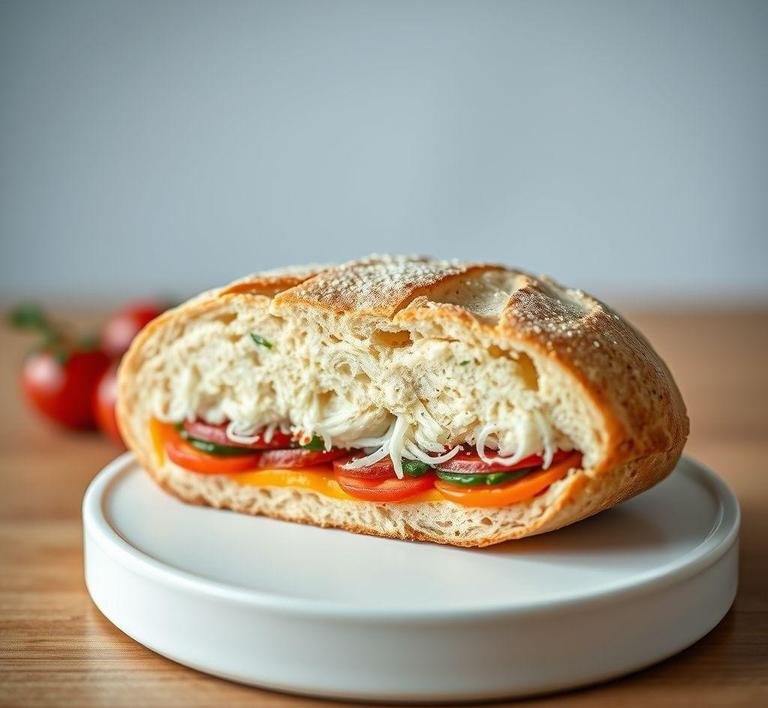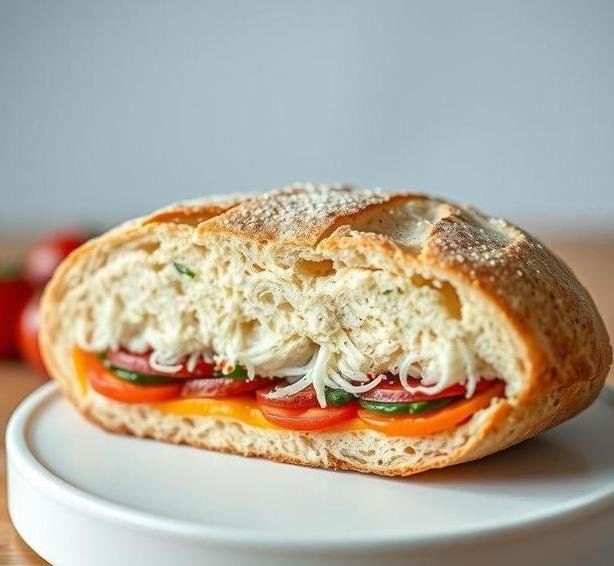Mary Berry’s Ciabatta Tricolore is a delightful twist on the classic Italian ciabatta bread. The term "Tricolore" refers to the iconic green, white, and red color scheme of Italy’s national flag, and this recipe creatively mirrors that by incorporating vibrant colors into the dough itself. With this bread, the traditional airy, slightly rustic texture of ciabatta is enriched by the inclusion of green (often spinach or basil), white (the natural color of the dough), and red (tomato or sun-dried tomato) ingredients.
This dish reflects Berry’s mastery of combining simplicity with bold flavors. The beautiful colors are not just visually striking but also add layers of distinct taste, making it a wonderful accompaniment to Mediterranean-inspired meals, fresh salads, or as part of a hearty sandwich. Whether served warm or at room temperature, this bread is perfect for an elegant starter or as an accompaniment to a main course.
Mary Berry’s Ciabatta Tricolore Recipe
Ingredients Needed

To make Mary Berry’s Ciabatta Tricolore, you’ll need a selection of fresh ingredients to ensure the best flavor and texture. Here’s a breakdown of the essentials:
- Strong White Bread Flour – The base of any good ciabatta is strong white bread flour. This flour has a higher protein content, which helps create the dough’s signature structure and airy crumb.
- Yeast – Active dry yeast or instant yeast works best for this recipe. It helps the dough rise, resulting in a light and airy bread.
- Salt – Essential for flavor, salt balances the sweetness of the flour and enhances the overall taste of the bread.
- Water – Lukewarm water is needed to activate the yeast and bring the flour together. The amount of water used may vary slightly depending on the flour’s absorbency.
- Olive Oil – A small amount of olive oil helps make the dough smoother and more pliable while adding a subtle depth of flavor.
- Fresh Basil – To achieve the green element, finely chopped fresh basil or spinach is added to the dough, giving it a fragrant herbal note and that beautiful green color.
- Sun-Dried Tomatoes – For the red element, chopped sun-dried tomatoes are folded into the dough. These add a rich, tangy sweetness and a punch of umami that contrasts beautifully with the other ingredients.
- Fresh Tomatoes – Optional for additional red tones and a burst of freshness.
Equipment Needed
While the ingredients are fairly simple, there are a few pieces of equipment you’ll need to bring this recipe to life:
- Mixing Bowl – A large bowl for mixing the dough ingredients. It’s important that it’s large enough to give the dough room to rise as it proves.
- Measuring Cups and Spoons – Accurate measurements are crucial for successful bread, especially when dealing with flour and yeast. A good set of measuring cups and spoons is essential.
- Wooden Spoon or Dough Hook – To stir and knead the dough. You can also use a stand mixer with a dough hook for convenience.
- Baking Tray or Pizza Stone – This is where the ciabatta will bake. A pizza stone is ideal as it creates a nice, even heat distribution, resulting in a crispier crust.
- Flour for Dusting – You’ll need a bit of extra flour to dust your work surface and shape the dough.
- Tea Towel or Cling Film – Used to cover the dough during the proving stage to prevent it from drying out.
- Sharp Knife or Scoring Blade – If you want to score the top of your ciabatta before baking, a sharp knife or special scoring blade will help you achieve neat, professional-looking results.
Instructions To Make Mary Berry’s Ciabatta Tricolore
- Prepare the Yeast Mixture: In a small bowl, combine the yeast with a bit of lukewarm water and a pinch of sugar to activate it. Let this sit for about 10 minutes until it becomes frothy.
- Mix the Dough: In a large mixing bowl, sift the bread flour and salt together. Make a well in the center and pour in the activated yeast mixture along with the remaining water and olive oil. Stir with a wooden spoon until it forms a sticky dough.
- Add the Flavorings: Divide the dough into three equal parts. Into one part, mix the chopped basil or spinach. Into the second, fold in the sun-dried tomatoes (and fresh tomatoes if using). Leave the third part as it is for the plain, white dough.
- Knead the Dough: On a lightly floured surface, begin kneading each section of dough individually for about 10 minutes or until it becomes smooth and elastic. You may need to sprinkle a bit of flour to keep it from sticking. The dough should be slightly sticky but manageable.
- First Proofing: Place each dough section into separate bowls, cover them with a damp tea towel, and leave them to prove in a warm place for 1-2 hours or until doubled in size.
- Shape the Dough: Once the dough has proved, gently punch it down to release the air and then shape it into three rectangular pieces. You can either braid these together or arrange them side by side to create a layered effect.
- Second Proofing: Place the shaped dough onto a floured baking tray, cover it again with a tea towel, and leave it to rise for another 30 minutes. During this time, preheat the oven to 220°C (200°C fan)/430°F.
- Bake: Score the tops of the loaves lightly with a sharp knife, then bake them in the preheated oven for 25-30 minutes or until golden brown. The bread should sound hollow when tapped on the bottom.
- Cool and Serve: Allow the ciabatta to cool on a wire rack for at least 15 minutes before serving. Slice and enjoy the soft, airy interior with the beautiful flavors from the basil, tomatoes, and the rich crust.
Tips And Tricks
- Dough Hydration: Ciabatta dough is traditionally quite wet and sticky, so resist the urge to add too much flour while kneading. This will give the bread its characteristic open crumb structure. If the dough is too dry, add a little extra water, a tablespoon at a time.
- Use a Pizza Stone: If you have one, using a pizza stone can help produce a crispier crust by evenly distributing the heat.
- Flavor Variations: While the Tricolore version is vibrant and flavorful, you can experiment with other ingredients. Try adding olives, roasted garlic, or even a handful of grated Parmesan for added complexity.
- Resting Time: Don’t rush the proving process. The longer the dough rests, the more flavor it develops. If you have the time, let it rise slowly in the fridge overnight.
- Storage: This ciabatta is best eaten fresh but can be stored for a couple of days in an airtight container. If it starts to lose its softness, you can revive it by heating it gently in the oven for a few minutes.
Mary Berry’s Ciabatta Tricolore is more than just a loaf of bread; it’s a celebration of color, flavor, and texture. The use of fresh basil, sun-dried tomatoes, and a soft, chewy crumb creates a stunning and delicious loaf that’s perfect for a variety of occasions, from casual meals to more formal gatherings. The combination of the traditional ciabatta style with these Mediterranean-inspired elements brings a beautiful harmony to the dish. With a bit of patience and care, you’ll have a beautifully vibrant and flavorful bread that’s sure to impress anyone at the table. Whether you’re a novice baker or an experienced home cook, this recipe is a delightful challenge and a true treat for the senses.
Easy Recipe Variations For Mary Berry’s Ciabatta Tricolore

Mary Berry’s Ciabatta Tricolore is a delightful twist on the classic Italian ciabatta bread, infused with vibrant colors and rich flavors. The addition of ingredients like sun-dried tomatoes, basil, and mozzarella, paired with the unique texture of ciabatta, makes this bread a stunning centerpiece at any meal. However, the beauty of Mary Berry’s recipe lies in its versatility, allowing for plenty of easy variations to suit different tastes, dietary preferences, and occasions.
- Herb-Infused Ciabatta Tricolore: If you’re looking to elevate the flavor profile of the bread, try adding fresh herbs like rosemary, thyme, or oregano into the dough. These herbs blend beautifully with the mozzarella and basil, adding depth to the flavor. You could also infuse olive oil with garlic and rosemary, brushing it over the dough before baking to give it a fragrant aroma.
- Gluten-Free Version: For those with gluten sensitivity or celiac disease, a gluten-free version of this tricolore can be made using a blend of gluten-free flours. You can replace the traditional bread flour with a mix of rice flour, tapioca flour, and potato starch to create a soft, airy ciabatta without gluten. There are many great gluten-free flour blends available in supermarkets, or you can mix your own for an authentic texture.
- Vegan Ciabatta Tricolore: If you’re following a vegan diet or simply want to skip the dairy, consider swapping the mozzarella for a dairy-free alternative. Many high-quality vegan cheeses mimic the creamy texture of mozzarella, making them a perfect substitution. For an even bolder twist, try using vegan pesto as a replacement for fresh basil leaves, adding a punch of flavor that pairs wonderfully with the sun-dried tomatoes.
- Spicy Tricolore: For those who love a bit of heat, adding finely chopped chili flakes or diced fresh chili peppers to the dough can give the bread a spicy kick. The chili’s sharpness balances beautifully with the sweet sun-dried tomatoes and the rich, creamy mozzarella, creating a more complex flavor profile. You could also drizzle a spicy olive oil over the baked bread for an extra layer of flavor.
- Sweet and Savory Ciabatta: For a sweet twist on the traditional Tricolore, try incorporating dried fruits like figs or cranberries into the dough. The natural sweetness of the fruit complements the savory sun-dried tomatoes, adding an interesting contrast. A touch of honey brushed on top before baking can add a glossy, sweet finish that contrasts with the tangy flavors of the tomatoes and the fresh basil.
- Ciabatta with Balsamic Glaze: Adding a drizzle of balsamic reduction over the finished bread enhances its flavors by adding a rich, tangy element. Balsamic vinegar pairs exceptionally well with mozzarella and tomatoes, creating a simple yet elegant flavor combination. You can either incorporate balsamic vinegar into the dough itself or use it as a finishing touch before serving.
Storing Leftovers
As much as you’ll likely want to devour Mary Berry’s Ciabatta Tricolore right out of the oven, it’s always a good idea to know how to store the leftovers properly to maintain their freshness and delicious texture.
- Room Temperature Storage: Ciabatta is best enjoyed within a few hours of baking, but if you have leftovers, storing them at room temperature is perfectly fine for up to 2 days. To keep the bread soft and fresh, wrap it in a clean kitchen towel or paper bag. This prevents the bread from drying out, while still allowing it to breathe.
- Freezing Ciabatta Tricolore: For longer storage, you can freeze your leftover Ciabatta Tricolore. Simply slice the bread before freezing to make it easier to grab individual portions. Wrap the slices tightly in plastic wrap or aluminum foil, and place them in an airtight freezer bag. When you’re ready to enjoy the bread again, simply toast or warm the slices in the oven for a few minutes to restore their crispy crust and soft interior. This method preserves the bread’s flavor and texture remarkably well.
- Reheating: If you haven’t frozen the ciabatta but need to store it for a few days, you can reheat the leftover bread in the oven to refresh its texture. Preheat the oven to 375°F (190°C), lightly mist the bread with water, and bake for 5-10 minutes. This will re-crisp the crust and warm the interior, giving it the just-baked texture you love.
- Storing with Toppings: If you’ve already assembled your Ciabatta Tricolore with toppings like mozzarella and sun-dried tomatoes, it’s best to eat it the same day as the toppings can cause the bread to become soggy if stored for too long. To avoid this, store the toppings separately in airtight containers and assemble the bread fresh when you’re ready to eat.
What To Eat With Mary Berry’s Ciabatta Tricolore?
Mary Berry’s Ciabatta Tricolore is versatile enough to pair with a wide range of dishes. Whether you’re serving it as a side or as part of a larger meal, here are some ideas for what to eat with it:
- Salads: Ciabatta Tricolore pairs wonderfully with fresh, crisp salads. A classic Caprese salad with ripe tomatoes, fresh mozzarella, and a drizzle of olive oil and balsamic vinegar complements the flavor profile of the bread. Alternatively, a Mediterranean salad with olives, cucumbers, and feta cheese will also harmonize beautifully with the ciabatta’s flavors.
- Grilled Meats or Veggies: The bread’s rustic, slightly chewy texture is perfect for accompanying grilled dishes. Serve it with grilled chicken, lamb, or a vegetable skewer for a Mediterranean-inspired meal. The smoky flavors of the grill will enhance the richness of the bread, and it can be used to soak up any delicious sauces or juices.
- Soups: A hearty soup is another great companion for Ciabatta Tricolore. Tomato soup (perhaps spiced up with a bit of basil or chili) is an obvious choice, given the connection with sun-dried tomatoes in the bread. For something a little different, pair it with a creamy butternut squash soup or a roasted vegetable soup. The ciabatta can be used to dip into the soup, soaking up the flavors beautifully.
- Cheese and Charcuterie Board: Serve slices of Ciabatta Tricolore as part of an elegant cheese and charcuterie spread. Pair it with a variety of cheeses-think creamy Brie, sharp Cheddar, or tangy goat cheese-and a selection of cured meats like prosciutto or salami. Add some olives, nuts, and fruit preserves for a well-rounded platter that perfectly complements the flavors of the bread.
- Bruschetta or Crostini: For a fun appetizer, use Ciabatta Tricolore as the base for bruschetta or crostini. Top it with a mixture of diced tomatoes, garlic, basil, and olive oil for a simple yet flavorful starter. You could also top it with roasted bell peppers, goat cheese, and a sprinkle of herbs for a more complex flavor combination.
Conclusion
Mary Berry’s Ciabatta Tricolore is a stunning and versatile bread that can elevate any meal. Its unique blend of fresh mozzarella, sun-dried tomatoes, and basil creates a beautiful harmony of flavors, while the light and airy texture of ciabatta makes it the perfect companion for a variety of dishes. Whether you stick to the classic recipe or explore easy variations, there’s no doubt that this bread will delight both the eyes and the taste buds.
By learning how to store leftovers properly and pairing the ciabatta with complementary dishes, you can extend the enjoyment of this bread well beyond the first bite. Whether you’re enjoying it as a simple side or creating a more elaborate spread with cheeses and meats, Mary Berry’s Ciabatta Tricolore offers endless opportunities to delight in its flavors.
FAQs
What Is The Key Difference Between Mary Berry’s Ciabatta Tricolore And A Traditional Ciabatta?
Mary Berry’s ciabatta tricolore takes the classic ciabatta recipe and adds a twist by incorporating vibrant colors and flavors through the addition of pesto, sun-dried tomatoes, and mozzarella. This creates a more visually striking loaf, with the rich green of the pesto, the red of the tomatoes, and the creamy white of the mozzarella, reflecting the colors of the Italian flag (‘tricolore’). In terms of texture, the bread is still light, airy, and crusty, similar to a traditional ciabatta.
How Long Does It Take To Make Mary Berry’s Ciabatta Tricolore From Start To Finish?
Making Mary Berry’s ciabatta tricolore typically takes around 4 to 5 hours in total. This includes time for proving the dough (which can take up to 2 hours), preparing the pesto, sun-dried tomatoes, and mozzarella filling, as well as baking time (around 30 minutes). However, much of this time is inactive waiting time for the dough to rise and prove, so it’s a great recipe to prepare in advance for a special meal.
Can I Use Store-bought Pesto And Sun-dried Tomatoes For Mary Berry’s Ciabatta Tricolore?
Yes, you can use store-bought pesto and sun-dried tomatoes for Mary Berry’s ciabatta tricolore if you’re looking to save time. However, homemade pesto will give you more control over the flavor and freshness. If you decide to go the store-bought route, look for a high-quality pesto made with fresh basil and olive oil to maintain the authentic taste of the recipe. Similarly, ensure your sun-dried tomatoes are packed in oil for the best flavor and moisture balance.


